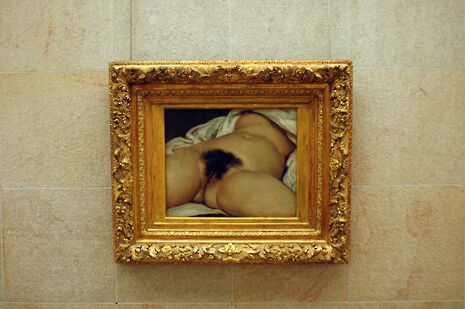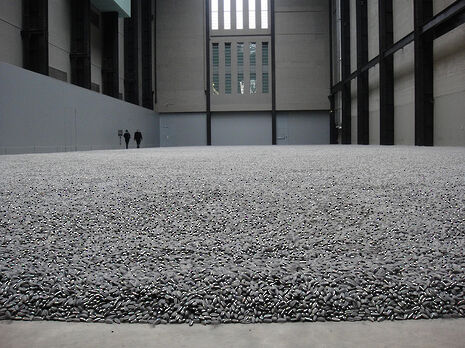Art Censorsh*p
Beth Cloughton explores the ongoing battle between the freedom of expression and censorship.

Art acts as a platform for emerging ideas, beliefs, and activism; or at least it should. Censorship of artworks has occurred since art became a public phenomenon, and many pieces are only recently having light shed upon them (see Courbet’s, The Origin of the World). Throughout art history, controlling what manifests in the public domain has been a concern of those most unfavourably depicted within the works, and continues still in contemporary artistry. Consider conceptual artist Ai Weiwei, who stated in a recent retrospective essay, On Self-Censorship, that “Censorship in China is enforced 24 hours a day...Its impact resounds in all forms of individual expression, be it a publication, an art show, or a website. For over 60 years, policies of censorship have been a pervasive part of society”. The figures and systems in positions of pervasive power can control what we, the public, do and do not see. Even within democratic nations, censorship consistently restricts what is shown; in America’s first amendment, freedom of expression is portrayed as a fundamental human right, yet the censoring of MacMonnies, Toche, and Bochovski pieces did not warrant such an American luxury.
Political activism is an aspect of the art world that creates potentially the most controversy, since leaders of governments and people in positions of corporate and religious power are usually at the core of the artists’ work. The art world is populated with seminal works; pieces earn such a title through their controversial social criticism and transgressive nature. Activism in art pushes against norms and standards of ‘decency’ in an ongoing battle between the freedom of expression and censorship. Politically motivated works paradoxically increase their visibility; again Ai Weiwei brought to light more than his initial sunflower piece had intended. Weiwei’s sunflower seeds highlighted the dictatorial nature of the Chinese Government, which brought the European Union and the United States to issue a protest condemning his detention. Censoring is a contentious issue even in contemporary society and striking the right balance between respect and expression is often hard to achieve. Within the art realm, much of the activism that has been silenced often comments on those abusing positions of power, like Pussy Riot, and those participating in the struggle to reclaim the female body.

Much of censored work is constituted of the female nude. Vulva, vagina, pube, and nipple galore have often breached the code of appropriate conduct, even in the 21st century. Most forms of online social networks like Instagram and Facebook have strict rules about what can and cannot be shown on an individual’s profile, even when the person at hand is liberating their body. By liberating their body I mean they are expressing themselves in a way that they want to be portrayed, be it through the appearance of a nipple or being completely covered. The contrast between the censorship of the female form when the agent at hand is shaping their image, compared to the lack of censorship in ‘revenge porn’, and typically male-conducted representations poses a struggle between freedom and patriarchal censorship. In 2014, female artist Angela Strassheim showed her work Janine Eight Months Pregnant at the Museum of Contemporary Art Jacksonville. Male president of Jacksonville city council brandished this piece as pornography in an attempt to censor the public’s accessibility. Fortunately, the Jackson Cultural Council argued that it "stands ready to defend the artistic and curatorial choices of our cultural service grantees". Again, in 2005, ‘Bad Subjects’ Magazine published an article commenting on how “female artists who critically explore sex and sexuality have been hard hit by censorship in Poland”, (see Dorota Nieznalska) through the use of violent physical force.
Contemporarily society is yet to overcome the ‘shock’ of the nude form. Ironically, large portions of the public who do not have such qualms with negative and detrimental portrayals of people in certain categories of pornography, or in producing a sterilized and capitalized form of beauty ‘ideals’, bear arms when it depicts the commonplace phallus. Suddenly in 2011 a hanging penis was confronted, not with joy, but with embarrassment and a reaction more appropriate to a 17th century nunnery. The restoration of a religious 13th century mural about the 'Tree of Fertility', attempted to sanitize the piece that was occupied with a copious amount of decorative penises. Gabriele Galeotti, the town councilor of where the mural was being restored commented, “Many parts of the work seem to have been arbitrarily repainted”. This act of censoring actually emphasized what was trying to be ignored and removed: male genitals.
Censoring can act to prevent destructive representations and offensive attacks but the censoring of art, especially in a space designed to present works from a multitude of perspectives, seems to contradict the role of the gallery and of the artist. The artist comments on, reflects upon, and addresses society. Prohibition of works that directly engage with aesthetics compromises the influence of the piece and the role of the artist. This may or may not be an explicitly good thing, but art is a tool with which to challenge preconceived ideas, stronghold beliefs, and to provoke a new wave of thought. There is a paradox in the practice of art censorship in that art functions to reflect society, and thus the more the power at play suppresses artistic expression, the more the art will portray.
Art has, and will continue, to play an important role in affecting society and its politics. If art were truly an autonomous practice there would be less, if no examples of censorship. Expression of thought within art challenges the status quo and provides a stage for a multitude of people to support what could perhaps be an endangered minority, pushed into silence by powerful institutions that benefit from public censoring. If art, a practice based on self-expression, is censored globally, what else is kept hidden?
Some Censored Artists and their Work:
1565- Michelangelo’s “The Last Judgement”
1865- Edouard Manet’s “Olympia”
1866- Gustave Courbet’s “The Origin of the World” (great portrait of a vulva)
1894: Frederick MacMonnies’ “Bacchante and Infant Faun”
1933: Diego Rivera’s “Portrait of America” (destroyed)
1960’s: Carolee Schneemann’s “Interior Scroll”
1969: Dorothy Iannone’s Depictions of “Ecstatic Unity”
1974: Jean Toche’s “Flyers”
1987: Andres Serrano’s “Piss Christ”
1989: Robert Mapplethorpe’s “The Perfect Moment”
1989: ‘Dread’ Scott Tyler’s “What is the Proper Way to Display the US Flag”
1990: Karen Finley’s “We Keep Our Victims Ready”
1990: The NEA Four “The Return of the Chocolate-smeared Woman”
1992: Dayton Claudio’s “Sex, Laws and Coat hangers”
1992: Sally Mann’s “Immediate Family”
1998: David Nelson’s “Mirth and Girth”
1999: Chris Ofili’s “The Holy Virgin Mary”
2000: Maurizio Cattelan’s “La Nona Ora/The Ninth Hour”
2000: Christian Marclay’s “Guitar Drag”
2000: Tony Oursler’s “The Influence Machine”
2001: Charles Moffat’s “United States Censorship”
2002: Dorota Nieznalska “Pasja”
2006: Daniel Edwards’ “Monument to Pro-Life: The Birth of Sean Preston”
2006: Daniel Edwards’ “Bust of Hilary Clinton”
2006: Muayad Muhsin’s “Picnic”
2007: Daniel Edwards’ “Paris Hilton Autopsy”
2007: Daniel Edwards’ “Prince Harry Dead in Iraq War Memorial”
2010: Blu’s “Entrance Mural”
2010: Rose Bochovski’s “Second Life”
2012: Pussy Riot’s “Punk Prayer-Moter of God, Chase Putin Away”
2014: Ai Weiwei “Sunflower Seeds”
2014: Brett Bailey’s “Exhibit B”
 News / Caius mourns its tree-mendous loss23 December 2025
News / Caius mourns its tree-mendous loss23 December 2025 News / Clare Hall spent over £500k opposing busway 24 December 2025
News / Clare Hall spent over £500k opposing busway 24 December 2025 Comment / The ‘class’ of Cambridge24 December 2025
Comment / The ‘class’ of Cambridge24 December 2025 Comment / Yes, I’m brown – but I have more important things to say22 December 2025
Comment / Yes, I’m brown – but I have more important things to say22 December 2025 Interviews / Politics, your own way: Tilly Middlehurst on speaking out21 December 2025
Interviews / Politics, your own way: Tilly Middlehurst on speaking out21 December 2025







